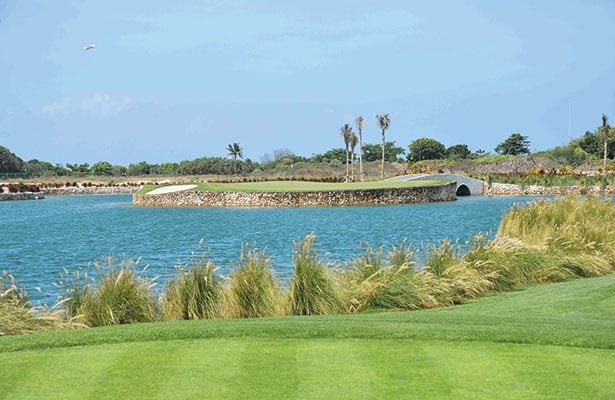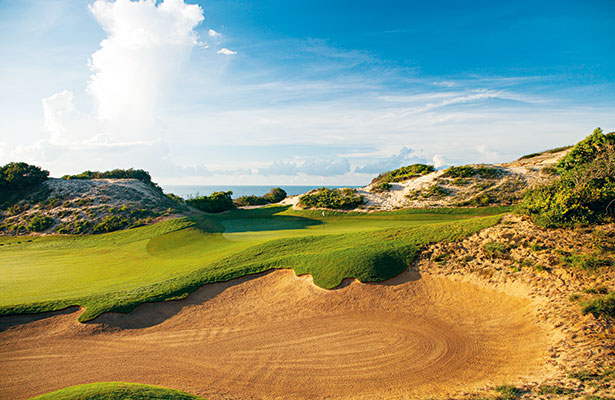Asia’s best new golf courses are ready for an influx of eager Aussies this summer.
IF THERE was to be a Big Bang in the current black hole of international golf course development, it would be in Asia – southeast Asia to be exact. While courses in China are closing due to the government’s efforts to curtail unauthorised golf course construction, and Japan faces challenges from an ageing population and a lacklustre business environment, developing countries farther south are viewing golf as the next stage in their economic maturity.
Between 2010 and 2014, 185 new courses opened in Asia, while 92 were being developed. In 2014 alone, 12 launched officially. Vietnam looks to be going through a golf boom, if the number of courses being built or planned is any indication. With more than 30 courses at present, that number is set to double during the next decade – possibly sooner.
And these new courses are not run-of-the-mill layouts built to sell apartments and villas. No, the construction of these new, high-end properties push the boundaries of quality and luxury. To top it off, they’re being designed by golf’s top architects.
From Thailand to Vietnam and Indonesia, we explore the best golf courses opened for play during the past two years. These layouts offer some light at the end of tunnel, and a chance to put Asian golf on the map.
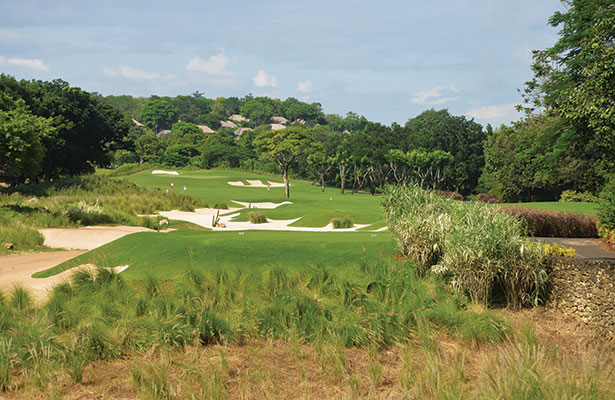 BALI NATIONAL GOLF COURSE
BALI NATIONAL GOLF COURSE
Bali, Indonesia [above]
THE former Bali Golf and Country Club in Bali’s upscale, touristy, Nusa Dua area was long overdue for a revamp after playing host to international visitors during the last two decades. Nelson & Haworth Golf Architects were hired to rebuild the course, and transformed it from an anachronistic, resort layout lacking cohesion in design philosophy, into a course for which people might make the trip to this fabled island.
Its topography meanders through thick forest, up and down hillocks, and out towards the Indian Ocean. Standing on the elevated grounds of the sixth hole, one has a panoramic view of Nusa Dua’s dramatic coastline and Lombok’s gigantic mountains. These are just some reasons why Bali National golf course is much loved by fans of the sport.
Breathtaking scenery aside, the refurbished 6,552-metre course underwent an 18-month overhaul and reopened last March. Now, it throws up a host of different challenges all in one seamless continuum.
Hazards – be it bunkers, water, pinched fairways, ravines, or walls of trees – are laid out clearly so a tourist golfer can easily navigate his way through a morning round and be on time for lunch at the villa.
Some holes are reminiscent of the old layout. The 10th still doglegs right to a green that is perched on the far-end hook of a crescent-shaped par 4, which is lined by sand bunkering on the right. The eighth remains a tough nut to crack, with its narrow entrance from the tee, villas to the right and trees on the left.
While fairways are wide enough to let rip from the tee with long clubs, the greens are not as easy. Most are built on raised mounds, or have sloping contours, meaning golfers need to be able to hone high-spinning approaches to keep it close to the flag.
Water comes into play on six holes, with the 17th boasting the most spectacular view of the Indian Ocean. This is, after all, one of Bali National’s signature holes – an island par 3 reminiscent of TPC Sawgrass’ 17th – and is as picturesque as it is deadly to your scorecard.
The revamped clubhouse now boasts a restaurant and lounge that offers a wonderful view of the 18th green. Only 15 minutes from Bali Ngurah Rai Airport via the new toll road that circumvents Denpasar, this is the perfect course to play upon arrival or just before departure.
Green fees from AU$250; complimentary transfers to and from hotels in Nusa Dua and Tanjong Benoa; balinationalgolfclub.com
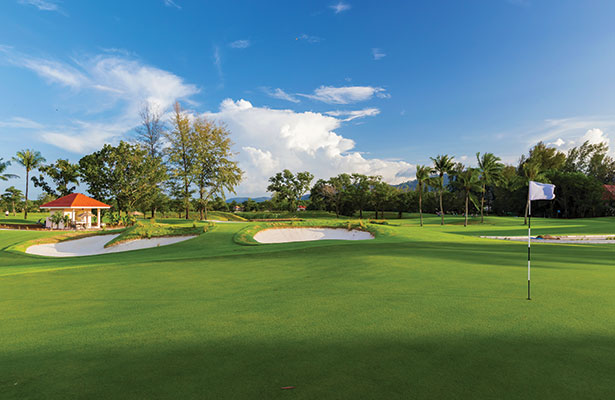 LAGUNA PHUKET GOLF CLUB
LAGUNA PHUKET GOLF CLUB
Phuket, Thailand [above]
THE recently redeveloped 18-hole championship course at Laguna Phuket Golf Club illustrates why Phuket remains one of the most attractive places in the region to tee off at.
Redesigned by award-winning architect Paul Jansen, the new course has little in common with the former, resort-style layout and adheres to the features of classical links courses. Furrows along fairways now make balls dance right and left, depending on the fate on any given shot. Green complexes have become monumental mounds of undulating turf to challenge approaches and putts.
To reduce maintenance costs, bunkers are down from 100 to 37 and sand areas are now fewer than half of the original. Jansen also reduced grass areas by over 30 per cent, so there is less water consumption. Woodchips and mulch generated from felled trees now feature in the rough areas.
Perhaps the one feature raising eyebrows is length. The course now plays somewhat shorter than the 6,400m monstrosities that pervade modern designs. “I wanted to show that a golf course can be a little over 6,120m, and just a par 71, and still test the best golfers,” Jansen says.
Laguna Phuket shows length isn’t everything. Those who are long off the tee may need to keep their drivers in the bag for some holes. The first, for instance, is risk-reward in its true form. With a skewed fairway, and a tree blocking the right side, a good drive may leave one with a short wedge to this 360m par 4. But anything right or left will leave one reaching for a second ball.
Strategy is key to negotiating many holes, as knowing where to place tee shots can result in either a shot at birdie, or having no shot at all. But those who drive well and long can dominate the par 5s, and come home with a score that just might make the short trip even more memorable.
Green fees from $178; lagunaphuketgolf.com
 NIKANTI GOLF CLUB
NIKANTI GOLF CLUB
Nakhon Pathom, Thailand [above]
NIKANTI opened a year ago and is arguably Thailand’s most unique golf development. While most 18-hole courses are built in two halves of nine holes, Nikanti, has chosen to divide itself into three sixes. This marvel is located in the Nakhon Pathon region, 1.5 hours east of Bangkok.
Designed by Thai architect Piraporn Namatra of Golf East, this configuration hopes to address the plight of golfers who lament that nine holes are too short, and 18 take too long. This gives them an option to play six, 12 or 18 holes, depending on how much time they have. Golfers can start from any of the three groups of six holes – each with two par 3s, two par 4s and two par 5s. Why didn’t anyone think of this before?
The course sits on relatively flat terrain, but Namratra’s clever use of bunkering provides an inherent movement that veers one away from the straightforward. Sand hazards are immaculately built, and provide ample protection of the greens. When sand doesn’t come into play, water works in tandem to keep golfers from par. Given the shortage of elevation changes, both elements stand vigil on nearly every hole to keep players from scorching up the relatively short course (6,208m from the Black tees).
All hazards of each hole are laid out bare, tempting golfers to take them on. Many holes skirt around ponds, prompting golfers to pick distances and club to bite off only as much as one can chew. Take too much and one braves running out of fairway. Too little and the drink awaits.
Another interesting aspect is that Nikanti is a pay-to-play development; it does not offer memberships. But that doesn’t mean it is crass. The elegant clubhouse, designed in a luxurious, modernist accent, feels rich and classy. Its registration counter looks more at home at a new age lounge than at a golf club – not that anyone would mind when greeted by lovely attendants in well-designed uniforms.
Tee times here have 15-minute intervals, and the daily fee includes chilled beverages found in the buggies. Caddies come as part of the charge, and a refreshing “no tipping” policy is in place here. Yet another element of this place that is not only forward thinking, but also makes sense from a customer’s perspective.
Green fees from $116, inclusive of GPS-equipped buggy, caddie fees and tip, and drinks; nikantigolfclub.com
 PINE ROCK GOLF CLUB
PINE ROCK GOLF CLUB
Qinhuangdao, China [above]
WHILE most golf developments in China are lying low, that’s not to say that courses aren’t being built. Pine Rock, for one, opened in July 2013, and showcases the kind of high-end attention to detail modern Chinese courses have come to be known for.
Designed and currently managed by IMG, the club, situated in the harbour city of Qinhuangdao, promises to set a new, luxury benchmark in this area.
Since it opened for play, the 18-hole course, located about 2.5 hours from Beijing, has already garnered rave reviews as one of the best new golf clubs in China. As its name suggests, rocky terrains are Pine Rock’s trademark – no surprise given Qinhuangdao’s reputation as a coal port. Topography rolls gently from hole to hole, often providing vantage points to the hill country in the distance. Mature pines and rock quarries lend themselves to a landscape that juxtaposes idyllically with the iconic rock cropping. The holes have varied length, variety and balance, offering something for all manner of handicaps.
Beyond the course, the clubhouse is a fine location to spend some time before or after a round. Designed in a contemporary style, its elevated position provides beautiful views across to Beidahe beach and the ocean beyond.
Green fees from $218, includes buggy, caddie, a set meal, and souvenir; pinerockgolf.cn
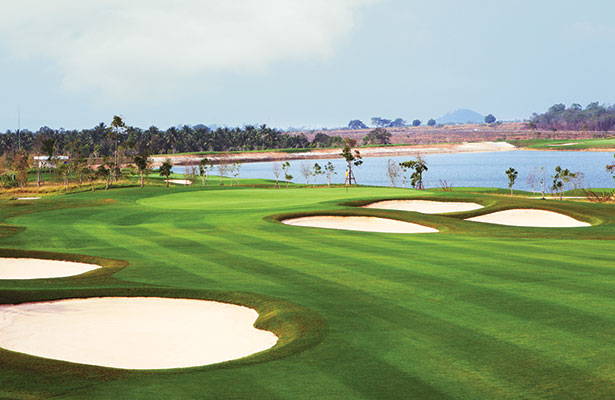 SIAM COUNTRY CLUB WATESIDE
SIAM COUNTRY CLUB WATESIDE
Pattaya, Thailand [above]
SIAM Country Club stands unblemished by the “colourful” reputation Pattaya has earned through the years. Providing visiting golfers with courses standing head and shoulders above its peers. The 44-year-old club celebrates its third course, Waterside, which opened last year. Waterside complements its existing Old and Plantation layouts.
While the Old course meanders through a parkland environment and Plantation has rolling hills, Waterside’s characteristic is the prevalence of water as its main defence. Though located immediately next to the other two courses, it offers a strikingly different experience. There is a vast openness, and the lack of trees and shrubs along the fairways opens up the horizon – all adding to the challenge of gauging distances.
While there is some undulation, the course lacks any serious vertiginous drops. There may not be ravines to cross and chutes of vegetation to negotiate, but getting around is hardly a walk in the park. At 6,816m from the back tees, Waterside is no walkover. Sand bunkers are stern hurdles to par, and water along the fairway on several holes urges golfers to choose their line carefully from the tee box.
Still, fairways are ample, which makes driving the ball onto the short grass somewhat forgiving. A word of advice is to choose appropriate tee boxes for maximum enjoyment.
Although ponds are a dominant feature, there are few forced carries. However, the rather arduous 201m, par-3 seventh does question resolve as golfers ponder which club to use to make it over the water hazard.
Off course, the clubhouse is as attractive and functional as the course is challenging and well maintained. Clean and modern, the terrace on the second level affords a nice view over the course, and makes for an apt place to recount the day’s adventures as the sun sets.
Green fees from $150; siamcountryclub.com
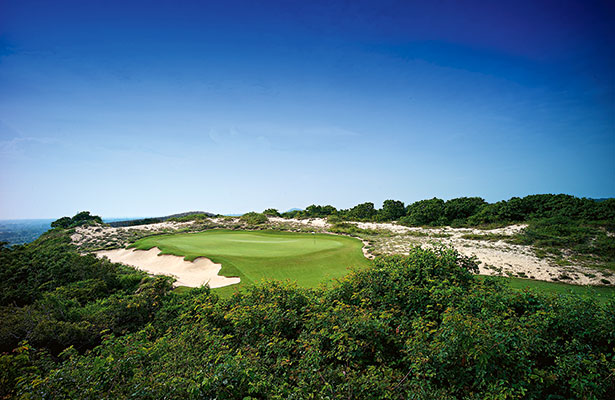 THE BLUFFS HO TRAM STRIP
THE BLUFFS HO TRAM STRIP
Ho Tram, Vietnam [above]
VIETNAM is undergoing a golf surge, with several new developments underway across the country. The Bluffs at Ho Tram Strip, which opened last October and is about two hours north of Ho Chi Minh, sets the bar for all those waiting in the wings to open.
Its location on the southern Vietnamese coastline could not be more ideal for golf. The ground tumbles from the sea upwards to 50m above sea level at the highest point, built over natural, towering sand dunes that evoke images of Scotland. The fine, firm sand is pristine and offers an ideal base for a Bermuda grass fairway conditioned so beautifully one would be embarrassed to carve a divot out of the ground.
Course designer Greg Norman was arguably a shoo-in for the job, having lent his hand to the famed Doonbeg Golf Club in Ireland. Both courses share similarities – they are situated along the coast and removed from urban civilisation. More notably, they are located on real estate that is near perfect to lay out 18 great holes of golf.
Norman’s design approach at The Bluffs is to offer golfers a wide fairway to hit off their drives and challenge their approach to large undulating greens. The nature of the land dictates that there are few flat lies to hit second and third shots from. There are hardly any straight putts, no matter where the ball lands on the greens.
The sensation of walking up each fairway is breathtaking, if not humbling. Many holes play like amphitheatres with walls of sandy dunes covered with indigenous brush, and populated with tram trees (pronounced “cham”, after which the area is named). Indeed, the precociousness of the new greens will have golfers scratching their heads as to how each putt breaks. That is part of the immense fun of playing The Bluffs.
For now, the course is the only one in the area, and the only place to stay at is The Grand Ho Tram Strip. Accommodations are superb, and the resort’s casino gives golfers a chance with Lady Luck at the tables if she didn’t show up on the golf course next door.
Stay and play packages $410; thebluffshotram.com

